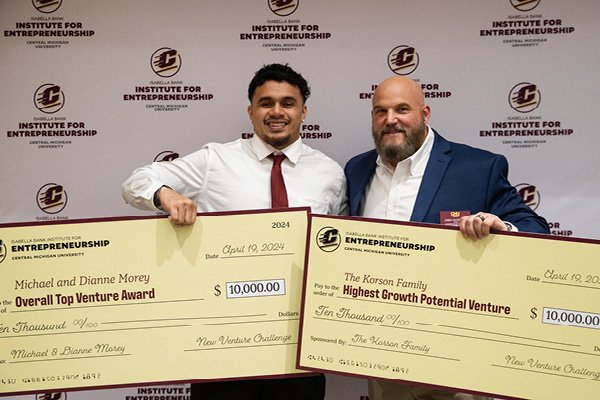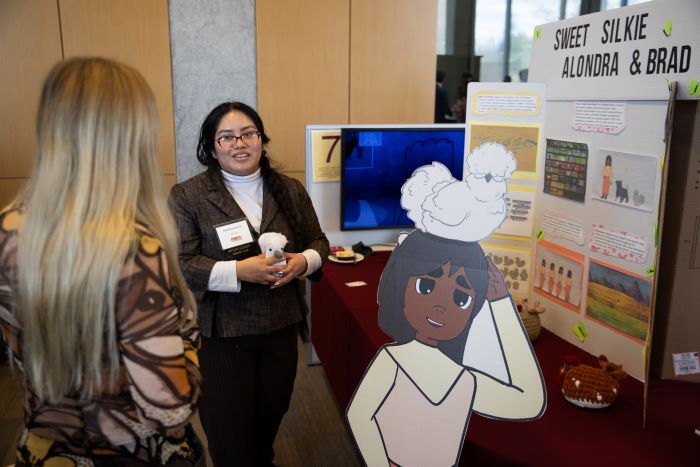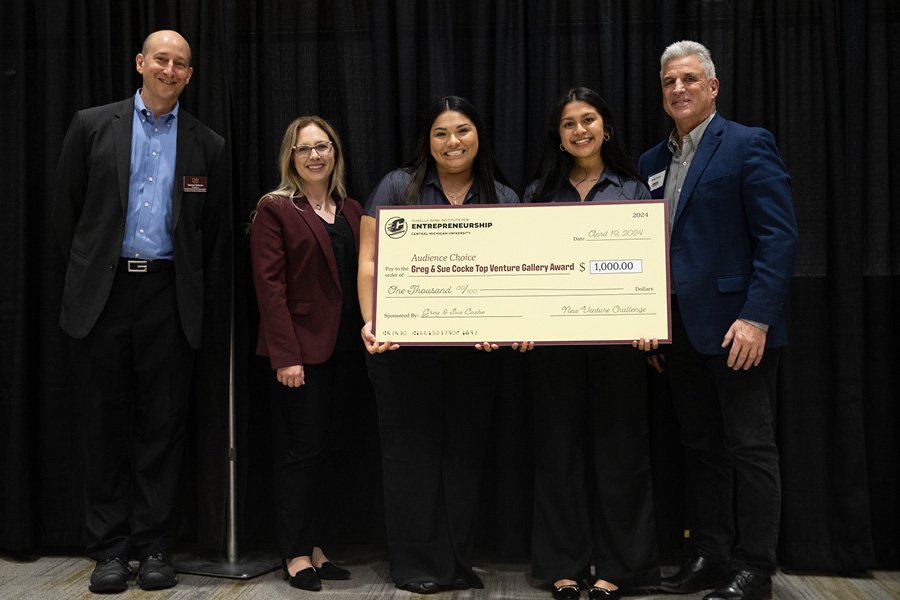
Start up
Passion. Potential. Pitches. Don't miss any of the 2025 New Venture Challenge excitement.
Tune in Friday, April 11 at 1 p.m. for great ideas and fierce competition. Then, join the judges, mentors, spectators and teams as they see who is going home with thousands of dollars in venture financing. The awards broadcast begins at 6:30 p.m. and one team will walk away as the overall best venture.
Central Michigan University’s College of Business Administration is the home of the Isabella Bank Institute for Entrepreneurship and the first Department of Entrepreneurship in the state of Michigan. We are a student-centric hub where experiential, curricular, and external entrepreneurial opportunities intersect.
Our mission is to maximize student success by fostering a campus-wide entrepreneurial mindset that promotes inter-disciplinary collaboration and the creation of new ventures.
We aim to create innovative programming, boost cross-campus and ecosystem collaboration and provide a comprehensive mentoring program.
Our institute provides extracurricular opportunities and is open to all undergraduate and graduate CMU students.
Are you interested in becoming an entrepreneur?
Every journey is unique. Explore the opportunities that interest you.
Meet vanadium. It’s a silvery metal and highly versatile. It is used to make armor plates and can tell us about Earth’s history that happened millions of years ago. A little bit might even lower your blood sugar.
If you want to unlock vanadium’s full potential, you need to know how it behaves, said Anthony Chappaz, a researcher in Central Michigan University’s earth and atmospheric sciences department.
Vanadium is also a trace element, a group of little-understood substances that are rare in nature. Like vanadium, each is also important in a lot of different ways. Making the most out of what we have is critical, he said.
The traditional scientific approach is to look at elements from the perspective of a specific applied use and extract as much as is available. Volume is prioritized over quality.
The problem is that demand will eventually run into the realities of a finite world.
It’s also an approach that places trace element usage into silos. Industry uses it for this. Medicine uses it for this. Paleoceanographers use it for this. It might have this application in agriculture.
Chappaz wants to help scientists break out of those silos and see trace elements like vanadium with greater complexity.
There are at least three different traits that help create a more complete picture of an element.
One is the traditional concept of concentration. How much of the element is in a particular deposit?
It’s also critical to think of an element based on atoms or molecules that are identical to each other. Each identical atom or molecule belongs to the same chemical species.
But natural forces can alter individual atoms or molecules such that, while they are chemically the same element, they have a lighter or heavier atomic mass. These variants are called isotopes
Different species and isotopes react uniquely in various situations and can provide added value in specific uses, he said. Scientists need to determine which variant – whether it’s a species or an isotope – of a trace element works best for different applications.
Doing that will allow scientists to focus on the best type of element and how to remove it from the environment with the least harm. Right now, however, scientists work in their silos and aren’t connected.
“This lack of connection, in my opinion, is what’s missing in modern science,” he said.
Chappaz sees himself as a facilitator, helping get scientists from different fields to talk about how to make the most of limited natural resources. He sees the work more like someone who helps others make the most of their tools.
“I need to tune their tools,” he said.
Right now, Chappaz is collaborating with scientists in Estonia, Denmark, China, Germany and Canada on vanadium in a formation that stretches from the Baltic states into Scandinavia.
An important step is understanding how trace elements like vanadium react during different chemical reactions caused by different natural phenomena. Those reactions will dictate which isotopes and species form and where they wind up.
“We are literally rewriting the way we think vanadium behaves in rocks,” Chappaz said.

Explore special opportunities to learn new skills and travel the world.

Present your venture and win BIG at the New Venture Challenge.

Boost your entrepreneurial skills through our workshops, mentor meetups and pitch competitions.

Learn about the entrepreneurship makerspace on campus in Grawn Hall.

Present a 2-minute pitch at the Make-A-Pitch Competition and you could win prizes and bragging rights!

Connect with mentors and faculty who are here to support the next generation of CMU entrepreneurs.

Are you a CMU alum looking to support CMU student entrepreneurs? Learn how you can support or donate to the Entrepreneurship Institute.